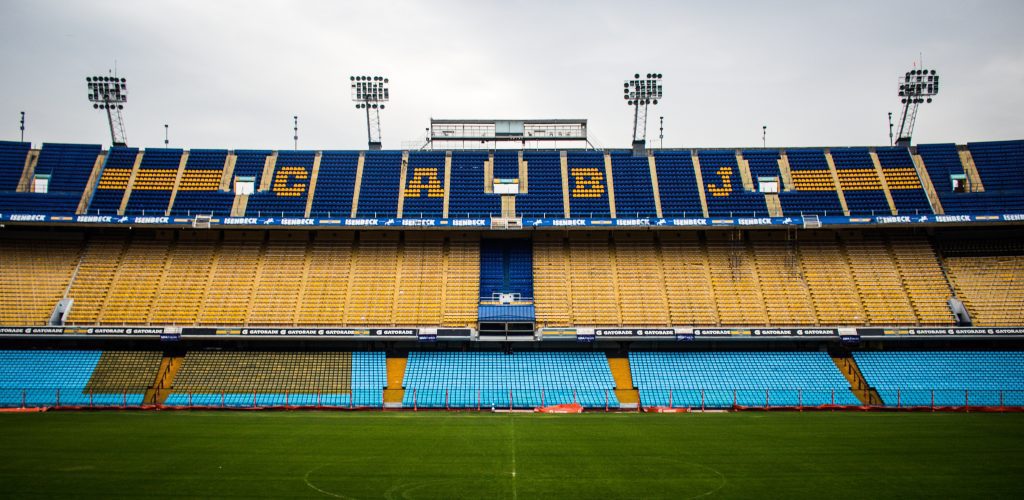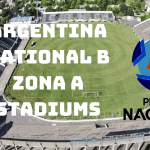The Argentinian Primera División, known officially as Liga Profesional de Fútbol, or Torneo Binance for sponsorship reasons, is a professional football league in Argentina. The league is hosted in some of the most iconic and impressive grounds in South America.
Argentine Primera División 2023 stadiums
Estadio Monumental Antonio Vespucio Liberti, commonly known as Estadio Monumental or River Plate Stadium, is a football stadium in Buenos Aires, Argentina. It is the home stadium of Club Atlético River Plate. With a capacity of approximately 70,000 spectators, it is the largest stadium in Argentina and one of the largest in South America. The stadium was built in 1938 and has hosted the 1978 FIFA World Cup Final between Argentina and the Netherlands.
The Estadio José Dellagiovanna is a football stadium located in Buenos Aires. It is the home venue of Club Atlético Tigre since it was inaugurated back in 1936. The stadium has a current capacity of 26,282 people.
The Estadio Tomás Adolfo Ducó is a stadium located in Buenos Aires. It is the home stadium of Club Atlético Huracán. The stadium was built in 1924 and has a capacity of around 49,000 spectators. It is named after Tomás Adolfo Ducó, a former president of Huracán.
The Estadio Alfredo Terrera is a stadium located in the city of Santiago del Estero. The stadium was inaugurated on 21 October 1946, has a capacity of 16,000 spectators, and is the home ground of Central Córdoba de Santiago del Estero.
The Estadio Gigante de Arroyito is a stadium located in Rosario. It is the home stadium of Rosario Central, one of the most popular soccer teams in the country, since its opening in 1925. The stadium has a seating capacity of approximately 42,000 spectators.
The Estadio José Fierro is a football stadium in the city of San Miguel de Tucumán. It is the home ground for Club Atlético Tucumán since its inauguration in 1922. The stadium’s capacity is now 35,200 due to extensive remodeling and several expansions.
The Estadio Claudio “Chiqui” Tapia is a stadium located in the Barracas neighborhood of Buenos Aires and is the home ground of club Barracas Central. The stadium has a capacity of 4,400 spectators which makes it the smallest in the Argentinian Primera Division for this season. It opened in 1916.
The legendary Alberto José Armando Stadium is a football stadium located in La Boca of Buenos Aires and has a capacity of 54,000 people. Widely known as La Bombonera is the home ground of Boca Juniors since 1940. The stadium is widely regarded as one of the most emblematic stadiums of the world.
The Florencio Sola Stadium is a football stadium in Banfield, Buenos Aires. The stadium was inaugurated in 1940 and since then is the home of Club Atletico Banfield. After several renovations, the stadium can now hold 34,901 people.
The Estadio Jorge Luis Hirschi, also known as Estadio Uno, is a stadium located in the city of La Plata. With a seating capacity of 32,230, the stadium is the home field of club Estudiantes de La Plata since 1907.
The Estadio Ciudad de Lanús – Néstor Díaz Pérez, also known as La Fortaleza (The Fortress) is a football stadium in Lanús, Buenos Aires. It is the home ground of Club Atlético Lanús. The stadium holds 47,027 people and was built in 1929.
The Estadio Ciudad de Vicente López is a stadium located in the neighborhood of Florida in Buenos Aires. The stadium was built in 1979, and has a capacity of 28,530 spectators. The stadium is the home of Club Atletico Platense.
The Estadio José Amalfitani is a stadium located in Buenos Aires. It is the home stadium of Club Atlético Vélez Sarsfield and is one of the largest stadiums in the country, with a seating capacity of around 49,540 spectators. The stadium was built in the 1950s and hosted 3 games of the 1978 FIFA World Cup.
The Estadio Mario Alberto Kempes, formerly known as Estadio Córdoba, is located in the city of Cordoba. It was built just before the 1978 world Cup where it hosted 8 games. Now it is used as the home stadium of Talleres de Córdoba. During 2010 and 2011 the stadium went through a remodeling process and the capacity was increased to 57,000, becoming the third largest stadium in Argentina by seating capacity.
The Julio César Villagra Stadium, also known as El Gigante de Alberdi, is a football stadium located in Córdoba. It opened on 17 March 1929, and since then it is the home ground of Club Atlético Belgrano. The stadium has a capacity of 35,000 people.
The Estadio Libertadores de América – Ricardo Enrique Bochini is a football stadium located in the district of Avellaneda in Greater Buenos Aires. It was built in 1929 and since then is the home ground of Club Atlético Independiente. It was demolished in 2006 and rebuilt in 2009 with a capacity of roughly 42,069 seats.
The Estadio Pedro Bidegain, also known as El Nuevo Gasómetro, is located in the Bajo Flores neighborhood of Buenos Aires. The stadium opened on 16 December 1993 and with a 47,964 seating capacity, it now serves as the home ground of San Lorenzo de Almagro.
The Estadio Juan Domingo Perón, popularly known as El Cilindro de Avellaneda, is a football stadium located in the Avellaneda district of Greater Buenos Aires. The stadium is the home venue of Racing Club. It opened on 3 September 1950 and has a capacity of 61,000 spectators, being the second largest stadium of Argentina, after Estadio Monumental.
The Estadio Malvinas Argentinas is a stadium in the city of Mendoza and is used as the temporary home of Godoy Cruz. With a seating capacity of 42,000 spectators, the stadium was built for the 1978 FIFA World Cup where it hosted 6 games.
The Estadio Marcelo Bielsa is a football-specific stadium located in the city of Rosario. Inaugurated in 1911, it is the home ground of the football club Newell’s Old Boys. Thw stadium has a seating capacity of 42,000 people.
The Estadio Brigadier General Estanislao López, popularly known as The Elephants Cemetery, is a football stadium in the city of Santa Fe. It was opened in 1946 and since then is the home of Club Atlético Colón. It currently has a capacity of 46,000 seats.
The Estadio Diego Armando Maradona is located in the district of Villa General Mitre in Buenos Aires. It is the home venue of club Argentinos Juniors and has a capacity of 26,000 people. It opened in 1940 and was renamed in 2004 in honor of the former Argentinos player Diego Maradona who made his professional debut in this stadium in 1976.
The 15 de Abril is a football stadium located in the city of Santa Fe. It opened in 1929 and since then it is the home of the local football club, Unión de Santa Fe. Currently, it has an approximate capacity of 30,000 people.
The Estadio Julio Humberto Grondona, also known as Estadio Viaducto, is a football stadium in the city of Sarandí. It opened in 1964 and it is currently used as the home stadium of Arsenal de Sarandí. The stadium holds 18,300 people.
The Estadio Norberto “Tito” Tomaghello is a stadium located in the district of Florencio Varela Partido in Greater Buenos Aires. It is the home ground for the club Defensa y Justicia. The stadium, inaugurated in 1978, has a current capacity of 20,000 spectators.
The Estadio Juan Carmelo Zerillo, also known as El Bosque is located in the city of La Plata, Buenos Aires. It is the stadium of the Club de Gimnasia y Esgrima La Plata. It opened in 1924 and nowadays has the capacity to accommodate approximately 21,500 spectators.
The Estadio Eva Perón is a stadium in Junín, Buenos Aires. It has a capacity of 22,000 spectators and is the home of Club Atlético Sarmiento since its inauguration in 1951.
The Estadio Presidente Juan Domingo Perón, also known as Monumental de Alta Córdoba is a football stadium in Córdoba. Since 1951, it is used as the home ground of Instituto de Córdoba. The stadium has a capacity of 26,000 people.





